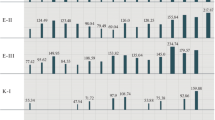Abstract
Strains of Drosophila melanogaster were made isogenic for their second chromosomes by means of the marker strain LCy/Pm. One of these strains was used as a founder for a homozygous experimental population (W). All other strains were mixed and established a heterozygous population (LKW). Both populations were free of lethals in the beginning with respect to their second chromosomes. After they had been exposed to an X-ray irradiation of 7000 r they contained about 26 per cent newly induced lethal chromosomes. Whereas in the heterozygous population the lethal frequency decreased rather fast to 10 per cent, that of the homozygous population remained rather constant at 25 per cent during a period of 135 days. After a year of continuation, however, both populations reached the same lethal frequency of about 10 per cent. Allelism tests carried out after 10 generations revealed that there was a highly heterotic lethal factor in the homozygous population. After excluding this heterotic lethal from the calculations, the lethal frequencies of the two populations remained significantly different. It was assumed that the relative mean fitness of lethal heterozygotes was generally higher in the homo-than in the heterozygous populations. The results indicate that homozygous populations are much more capable of incorporation new mutations than heterozygous.
Similar content being viewed by others
References
Dobzhansky, Th. (1970). Genetics of evolutionary processes. Columbia Univ. Press, New York.
Dobzhansky, Th. & B. Spassky (1963). Genetics of natural populations. XXXIV. Adaptive norm, genetic load and genetic elite in Drosophila pseudoobscura. Genetics 48: 1467–1485.
Falk, R. (1961). Are induced mutations in Drosophila overdominant? II. Experimental results. Genetics 46: 737–757.
Falk, R. & N. Ben-Zeey (1966). Viability of heterozygotes for induced mutations in Drosophila melanogaster. II. Mean effects in irradiated autosomes. Genetics 53: 65–77.
Ives, P. T. (1945). The genetic structure of American populations of Drosophila melanogaster. Genetics 30: 167–196.
Mayr, E. (1963). Animal species and evolution. Harvard Univ. Press. Cambridge.
Muller, H. J. & R. Falk (1961). Are induced mutations in Drosophila overdominant? I. Experimental design. Genetics 46: 727–735.
Sperlich, D. & A. Karlik (1970). The genetic conditions in heterozygous and homozygous populations of Drosophila I. The fate of alien chromosomes. Genetics 41: 265–304.
Sved, J. A. & F. Avala (1970). A population cage test for heterosis in Drosophila pseudoobseura. Genetics 66: 97–113.
Wallace, B. (1930). Allelism of second chromosome lethals in Drosophila melanogaster. Proc. natn. Acad. Sci. U.S.A. 36: 654–657.
Wallace, B. (1958). The average effect of radiation induced mutations on viability in Drosophila melanogaster. Evolution 12: 532–586.
Wallace, B. (1963). Further data on the overdominanee of induced mutations. Genetics 48: 633–651.
Wallace, B. (1970). Genetic load. Prentice-Hall, Englewood Cliffe, N.Y.
Author information
Authors and Affiliations
Rights and permissions
About this article
Cite this article
Sperlich, D., Karlik, A. The genetic conditions in heterozygous and homozygous populations of Drosophila. II. X-ray induced lethals in a homozygous and a heterozygous population. Genetica 43, 443–452 (1972). https://doi.org/10.1007/BF00156139
Received:
Accepted:
Issue Date:
DOI: https://doi.org/10.1007/BF00156139




